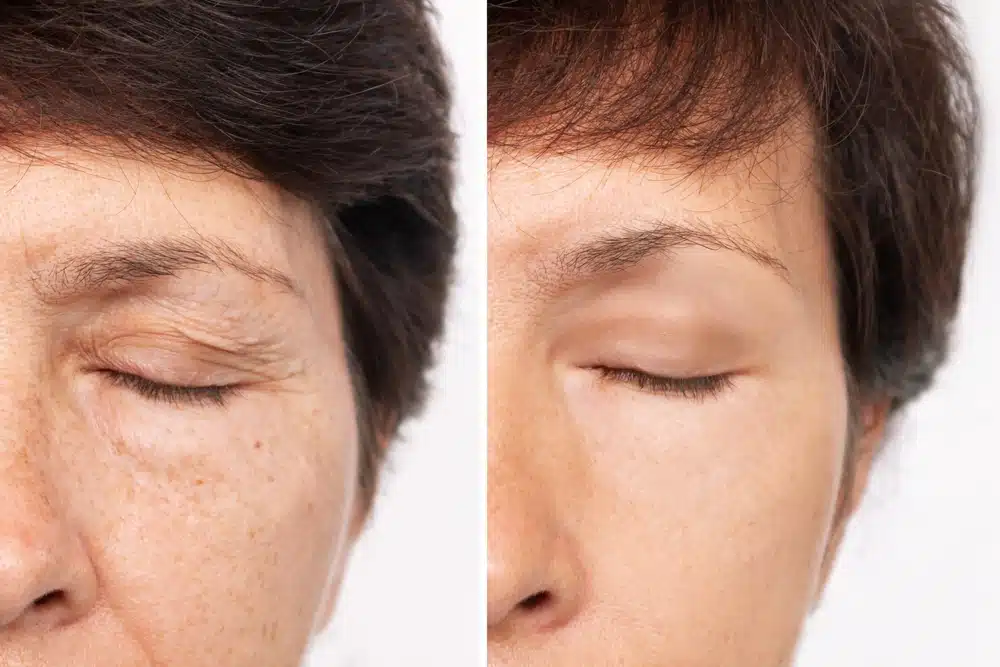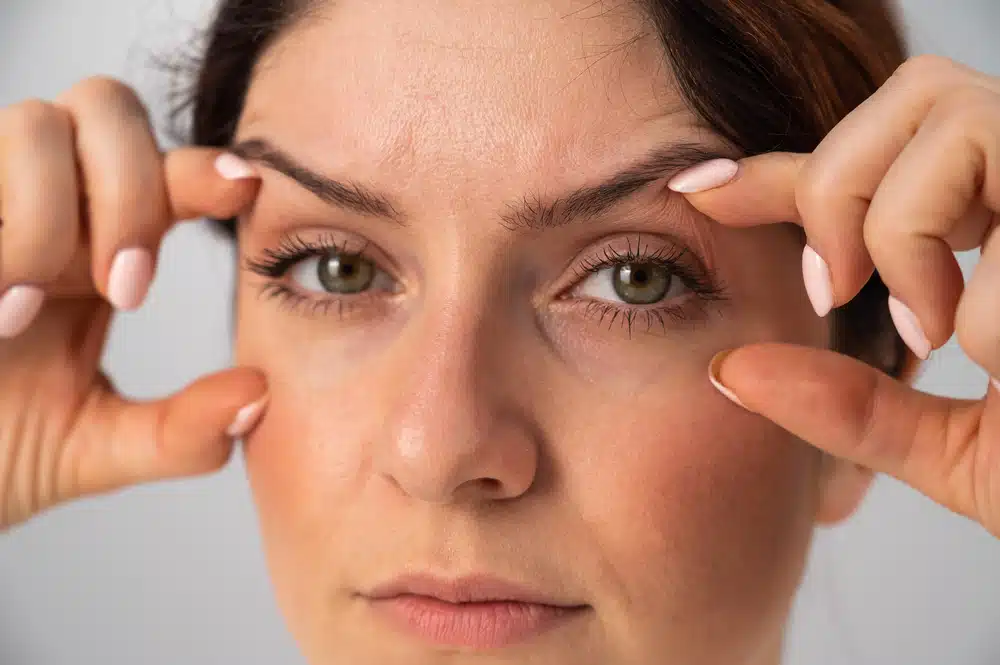
Blepharoplasty, or eyelid surgery, is a common cosmetic procedure with the potential to significantly enhance a person’s appearance. Like any surgical procedure, blepharoplasty can leave scars. However, with appropriate care, these scars can gradually fade and become less visible. This article will guide you on how to effectively manage your blepharoplasty scars for optimal healing and minimal visibility.
What is Blepharoplasty?
Blepharoplasty is a procedure addressing various eyelid concerns. It enhances eye appearance by removing excess skin, muscle, and fat from the upper or lower eyelids, reducing droopiness and eyelid bags for a youthful look. Besides cosmetic benefits, it corrects functional issues like eyelid ptosis correction and eyelid retraction, resulting in improved vision.
Upper vs. Lower Blepharoplasty
The blepharoplasty procedure can be performed on either the upper or lower eyelids, depending on the patient’s specific needs.
Upper blepharoplasty, a common operation, corrects upper eyelid concerns. Incisions along the natural crease minimize visible scarring, while excess skin and fat removal or muscle repair address droopy eyelids. This procedure enhances the hooded appearance for a youthful look.
Lower blepharoplasty addresses lower eyelid issues such as eyelid bags by repositioning fat, removing excess skin, and firming delicate tissues. Performed via an internal incision, this procedure minimizes visible scars and accelerates healing, enhancing appearance and function by tackling eyelid retraction and excess skin.
The Healing Process of Blepharoplasty Scars
The healing process of blepharoplasty scars is a gradual one and involves several stages.
Initial Weeks
In the initial weeks following the surgery, the incisions will begin to heal. Proper incision care is crucial during this period to prevent infection and promote optimal healing. The scar will initially appear red and may be slightly raised. This is a normal part of the healing process.
Long-term Healing
As healing progresses, upper eyelid surgery scars usually fade from red to pink, then to white or skin-colored. Typically located in the eyelid’s natural crease, these scars often become invisible or well-hidden. Full maturation and fading can take several months to a year.

Minimizing Scarring Post Eyelid Surgery
There are several steps you can take to minimize scarring after eyelid surgery.
Topical Treatments
Topical treatments, such as scar creams, can be beneficial in managing the appearance of blepharoplasty scars. These creams can reduce inflammation, keep the delicate healing incisions moisturized, and promote faster healing.
Lifestyle Changes
Certain lifestyle changes can also contribute to optimal scar healing. Avoiding direct sun exposure, using sunscreen, and maintaining a healthy diet can all support your body’s natural healing process. In addition, refraining from smoking can significantly improve your healing capabilities and minimize scarring.
The key to managing your blepharoplasty scars effectively is patience, proper care, and following your surgeon’s postoperative care instructions.
What Could Go Wrong with Blepharoplasty Scars
While most blepharoplasty procedures are successful, complications can sometimes occur. Understanding these potential issues can help you take proactive steps to prevent them.
Infection Risks
Infections can occur post-blepharoplasty. Signs include redness, swelling, or discharge at the incision site. Immediate contact with your surgeon is crucial if these symptoms appear. Adhering to postoperative care instructions, like maintaining cleanliness and taking antibiotics, can greatly minimize infection risks.
Keloid Formation
People prone to keloid scars, which are raised skin areas growing beyond the original scar boundaries, may experience itchiness, pain, or cosmetic issues. Discuss any history of keloid formation with your surgeon before surgery. They may suggest preventative measures like silicone sheets or steroid injections.
Expert Tips from Dr. Bustillo on Managing Scars
Dr. Bustillo emphasizes the importance of patience and diligent care in managing both upper and lower blepharoplasty scars and recommends following all postoperative instructions closely.
To ensure a smooth blepharoplasty recovery, it is recommended that the first night be spent in a calm and relaxed manner, with the head kept elevated with two pillows to reduce swelling and facilitate a better, restful sleep. In addition, to address potential swelling or discomfort around the eyes in the first two days, consider using cold compresses, and applying them for 10-minute intervals.
Dr. Bustillo also advises sticking to a liquid diet during the initial twelve hours post-surgery, particularly one that is rich in vitamins and nutrients that support skin health, like vitamin C and zinc, which can enhance your body’s ability to heal.
Fortunately, most patients experience minimal pain, which can usually be effectively managed with Tylenol. As an extra precaution, Dr. Bustillo will provide additional pain medication if needed. These expert suggestions are designed to optimize the healing process and effectively manage any potential scarring.
When to Seek Professional Help for Eyelid Surgery Scars
If your eyelid scars worsen or cause discomfort or vision issues during the healing period, contact your board-certified cosmetic surgeon. This is crucial for patients who’ve had upper eyelid surgery, eyelid lifts, or eyelid retraction, as these procedures involve delicate eyelid tissues and require careful monitoring. A consultation with your surgeon can help determine the next steps if scars don’t improve months after surgery.
FAQs on Blepharoplasty Scars
The initial healing process for both lower and upper blepharoplasty scars typically takes several days. However, the complete healing and maturation of scars can take between two to three months. During this time, the scars will gradually change from red to pink and eventually become white or skin-colored.
Blepharoplasty scars can fade significantly with proper care, but may not be entirely invisible. The procedure aims to hide incisions in the eyelid’s natural crease. Adhering to postoperative instructions, avoiding sun, and using prescribed scar creams can help reduce scar visibility.
Signs of infection in blepharoplasty scars may include increased redness, swelling, or discharge from the incision site. Fever or increased discomfort may also indicate an infection. If you notice any of these signs, it’s crucial to contact your surgeon immediately.
For quicker healing of eyelid surgery scars, adhere to your surgeon’s postoperative instructions. This includes maintaining the cleanliness of the incision site, using prescribed creams, and avoiding smoking and sun exposure. Refrain from strenuous activities post-surgery to prevent strain on healing incisions. A healthy diet and proper rest also aid in faster recovery.
Yes, Dr. Bustillo is a highly-regarded, double board-certified facial plastic surgeon with over 20 years of experience. He has extensive expertise in managing and treating blepharoplasty scars. His comprehensive approach to patient care, combined with his surgical skill and attention to detail, ensures that his patients achieve optimal results with minimal scarring.

